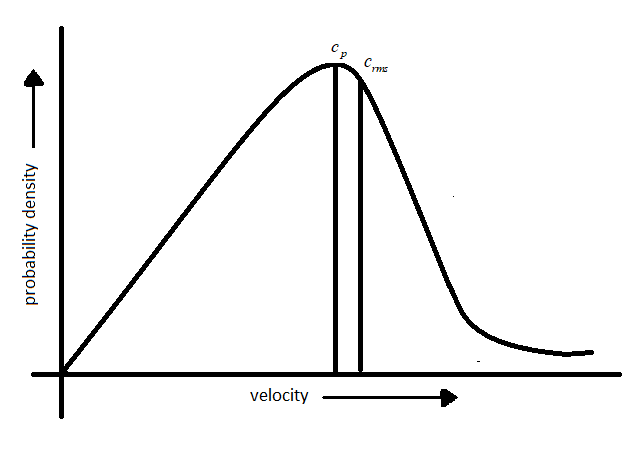
Answer
459.6k+ views
Hint: we should know why we study Boltzmann-Maxwell distribution of molecular velocity and know to study the graph under this concept, understanding these two points help us to answer this question within no time.
Complete step by step answer:
Due to molecular collision velocity molecules in a gas sample differ continuously as they move in different directions and different velocities. Basically, there will be distribution velocity among the molecules. Based on probability consideration Maxwell Boltzmann gave velocity among the molecules.
\[f(c)dc = 4\pi {(\dfrac{M}{{2\pi RT}})^{\dfrac{3}{2}}}\exp (\dfrac{{ - M{c^2}}}{{2RT}}){c^2}.dc = \dfrac{{dNc}}{N}\]…………………Equation 1
Divide the equation 1 by dc
\[f(c) = 4\pi {(\dfrac{M}{{2\pi RT}})^{\dfrac{3}{2}}}\exp (\dfrac{{ - M{c^2}}}{{2RT}}){c^2} = \dfrac{1}{N}.\dfrac{{dNc}}{{dc}}\]…………………Equation 2
Where, M = Mass of the gas molecule.
C = velocity possessed by gas molecule
dc = small change in the velocity
N = Total number of molecule
$f(c)$= fraction of molecule having velocity between c and $c + dc$
$\dfrac{1}{N}.\dfrac{{dNc}}{{dc}}$ is known as probability density
In order to get the velocity distribution in gas molecules,the probability density versus which gives the velocity distribution in a sample of gas containing N molecules.

Based on the equation 2, three velocities are proposed:
-Most probable velocity: The velocity possessed by maximum number of molecules is represented by most probable velocity which is denoted by$({c_p})$.
-Root means square velocity: The square root of the mean of the square of the different velocities possessed by molecules of a gas at a given temperature and is denoted by (${c_{rms}}$).
-Average velocity: The arithmetic mean of different velocities possessed by the molecules of the gas at a given temperature and is denoted by (${c_{av}}$).
From the definition and graph mentioned above it is evident that the peak of the curve corresponds to most probable velocity.
Thus, option B is the correct answer.
Note: Other observation from the graph:
- Fraction of molecules passing close to zero and very high velocity is very small.
-The area under the curve gives the fraction of molecules having velocity between c and $c + dc$.
-The fraction of molecules possessing higher velocity initially increases and reaches a maximum then declines.
-The probability function will be greater which reflects on the broadness of the curve.
Complete step by step answer:
Due to molecular collision velocity molecules in a gas sample differ continuously as they move in different directions and different velocities. Basically, there will be distribution velocity among the molecules. Based on probability consideration Maxwell Boltzmann gave velocity among the molecules.
\[f(c)dc = 4\pi {(\dfrac{M}{{2\pi RT}})^{\dfrac{3}{2}}}\exp (\dfrac{{ - M{c^2}}}{{2RT}}){c^2}.dc = \dfrac{{dNc}}{N}\]…………………Equation 1
Divide the equation 1 by dc
\[f(c) = 4\pi {(\dfrac{M}{{2\pi RT}})^{\dfrac{3}{2}}}\exp (\dfrac{{ - M{c^2}}}{{2RT}}){c^2} = \dfrac{1}{N}.\dfrac{{dNc}}{{dc}}\]…………………Equation 2
Where, M = Mass of the gas molecule.
C = velocity possessed by gas molecule
dc = small change in the velocity
N = Total number of molecule
$f(c)$= fraction of molecule having velocity between c and $c + dc$
$\dfrac{1}{N}.\dfrac{{dNc}}{{dc}}$ is known as probability density
In order to get the velocity distribution in gas molecules,the probability density versus which gives the velocity distribution in a sample of gas containing N molecules.

Based on the equation 2, three velocities are proposed:
-Most probable velocity: The velocity possessed by maximum number of molecules is represented by most probable velocity which is denoted by$({c_p})$.
-Root means square velocity: The square root of the mean of the square of the different velocities possessed by molecules of a gas at a given temperature and is denoted by (${c_{rms}}$).
-Average velocity: The arithmetic mean of different velocities possessed by the molecules of the gas at a given temperature and is denoted by (${c_{av}}$).
From the definition and graph mentioned above it is evident that the peak of the curve corresponds to most probable velocity.
Thus, option B is the correct answer.
Note: Other observation from the graph:
- Fraction of molecules passing close to zero and very high velocity is very small.
-The area under the curve gives the fraction of molecules having velocity between c and $c + dc$.
-The fraction of molecules possessing higher velocity initially increases and reaches a maximum then declines.
-The probability function will be greater which reflects on the broadness of the curve.
Recently Updated Pages
10 Examples of Evaporation in Daily Life with Explanations

10 Examples of Diffusion in Everyday Life

1 g of dry green algae absorb 47 times 10 3 moles of class 11 chemistry CBSE

What happens when dilute hydrochloric acid is added class 10 chemistry JEE_Main

What is the meaning of celestial class 10 social science CBSE

What causes groundwater depletion How can it be re class 10 chemistry CBSE

Trending doubts
Fill the blanks with the suitable prepositions 1 The class 9 english CBSE

Which are the Top 10 Largest Countries of the World?

How do you graph the function fx 4x class 9 maths CBSE

Who was the leader of the Bolshevik Party A Leon Trotsky class 9 social science CBSE

The Equation xxx + 2 is Satisfied when x is Equal to Class 10 Maths

Differentiate between homogeneous and heterogeneous class 12 chemistry CBSE

Difference between Prokaryotic cell and Eukaryotic class 11 biology CBSE

Which is the largest saltwater lake in India A Chilika class 8 social science CBSE

Ghatikas during the period of Satavahanas were aHospitals class 6 social science CBSE




